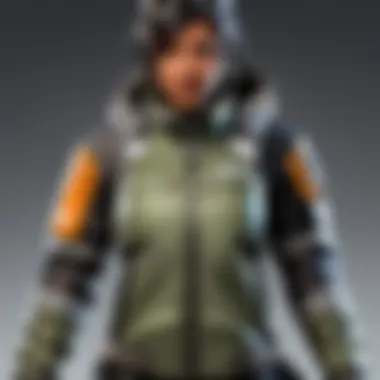North Face Apex Bionic 1 vs 2: A Detailed Comparison


Intro
The North Face Apex Bionic jackets, known for their versatile applications, have gained significant traction among outdoor enthusiasts and urban dwellers alike. This analysis seeks to shed light on the intricate nuances and key distinctions between the Apex Bionic 1 and Apex Bionic 2 models. Both jackets are tailored for different experiences and conditions, warranting a deeper look into their features.
Through an evaluation of design principles, functional performance, and user feedback, we aim to produce a well-rounded insight into these two excellent jackets. The comparison covers core aspects like material quality, insulation techniques, and weather resistance capabilities. Understanding these elements assists potential buyers in making more informed decisions suited to their unique requirements.
Design Comparison
In terms of design, both the Apex Bionic 1 and Apex Bionic 2 exude a modern aesthetic. The Apex Bionic 1 presents a straightforward look, offering a minimalistic approach. Its materials are durable yet see considerable divergence in breathability and texture compared to its successor.
Conversely, the Apex Bionic 2 introduces refined fabrics that contribute to greater flexibility and comfort. This newer model incorporates an ergonomic structure, addressing mobility concerns during dynamic outdoor activities. Notably, its design also utilizes eco-friendly materials, aligning with growing consumer interest in sustainability.
Performance Evaluation
Material Properties
In detail, both jackets feature soft-shell construction, but their respective material choices diverge in terms of breathability and moisture-wicking abilities. The Apex Bionic 1 primarily employs TNF's WindWall fabric, designed to block wind effectively. However, the Apex Bionic 2 adopts an innovative fabric blend fostering increased air circulation, enhancing overall comfort during activity.
Insulation
While neither model prioritizes heavy insulation, the advancements in the Apex Bionic 2’s inner lining contribute to maintaining warmth more efficiently. User experiences reveal that the latter is preferable in slightly colder environments without compromising mobility.
Weather Resistance
When it comes to weather resistance, while both jackets exhibit competent performance in light rain and wind, the Apex Bionic 2 edges out via additional water-repellent treatments. The owner's feedback distinguishes that this jacket endures harsher conditions better than the original model.
User Feedback
In gathering opinions from various user experiences, a consensus indicates satisfaction with both jackets. The Apex Bionic 1 earns commendations for its simplistic approach, whereas the Apex Bionic 2 garners appreciation for its contemporary evolved design along with functional improvements.
Users clearly express document towards adaptability, functionality, and aesthetics. As the ultimate decision leans towards personal preferences, this narrative hopes to alleviate confusion buyers may have in choosing between the Apex Bionic 1 and the improved Apex Bionic 2.
Preface to North Face Apex Bionic Series
The North Face Apex Bionic series stands out in the outdoor apparel market due to its exceptional combination of functionality and design. Discussing this series is crucial as it sheds light on two particular models: the Apex Bionic 1 and Apex Bionic 2. These jackets promise diverse protection and mobility for outdoor enthusiasts and casual users alike.
Both models cater to different usage scenarios, ensuring that they meet specific needs. Understanding their unique features will help readers comprehend which model best serves their requirements.
The importance of the Apex Bionic series lies in its focus on technologically advanced materials, which enhance adaptability in a variety of environments. The jackets offer not only weather resistance but also an optimal synergy of comfort and utility.
Overview of the North Face Brand
The North Face, founded in 1966, is a renowned brand widely recognized for its commitment to innovation in outdoor equipment and apparel. The brand aims to empower people to explore and conquer either casual hikes or extreme adventures. Their extensive product line ranges from jackets to footwear, all designed with a focus on durable performance.
North Face emphasizes research and development to continuously improve material technology, which directly affects the efficacy of products like the Apex Bionic jackets. Their reputation for quality builds trust among outdoor enthusiasts and urban users alike.
Target Market for Apex Bionic Jackets
The Apex Bionic jackets target a broad demographic that includes outdoor adventurers, athletes, and those who endure specific environments while staying stylish. Users often require reliable outerwear that offers protection from wind and moisture while ensuring flexibility.
Furthermore, the jackets are appreciated by city dwellers who seek functional yet fashionable options for their day-to-day activities. The versatility of the Apex Bionic series is attractive to various consumer segments. Its design allows options for layering, making it an ideal choice for different seasons and conditions.
In summary, understanding the North Face Apex Bionic series is vital for individuals who wish to reconcile style and performance in one garment. Awareness of both models, informed by a solid grounding in the brand’s mission, enhances the buying decision for prospective consumers.


Material Composition
Material composition is a key factor in evaluating the performance characteristics of outdoor jackets, particularly the North Face Apex Bionic series. The materials used not only affect the durability and functionality of the jackets but also determine factors like comfort, insulation, and weather resistance. Choosing the right material can enhance the overall experience for users engaging in various outdoor activities. Understanding the specifics of fabric technology in both Apex Bionic 1 and Apex Bionic 2 is essential for informed purchasing decisions.
Fabric Technology of Apex Bionic
The Apex Bionic 1 jacket employs a durable soft-shell fabric primarily made for wind resistance and breathability. This fabric has a slight stretch that offers a comfortable fit while permitting movement, which is ideal for activities like hiking and climbing. The fleece backer adds to the comfort, efficiently holds body heat, adding a modest layer of warmth without constricting mobility. Customers have noted that while it provides adequate insulation, it lacks extreme weather protection.
Fabric Technology of Apex Bionic
The Apex Bionic 2 improves upon its predecessor with upgraded fabric technology that optimizes both warmth and flexibility. Its stretch fabric accommodates a wide range of motion and performance during active pursuits. The 100% windproof design greatly enhances protection against chilling winds, making this model suitable for harsher weather. The DWR finish contributes additional water-resistant capabilities, which help in damp conditions while maintaining comfort levels. Overall, many users recognize it as a significant advancement over the first model.
Comparative Analysis of Materials
In comparing the materials used in Apex Bionic 1 and Apex Bionic 2, it’s noticeable that the latter has a stronger focus on maximizing insulation while offering good weather resistance. Where Apex Bionic 1 invites users into a more versatile, yet less insulated experience, Apex Bionic 2 seeks to strike a balance between insulation and mobility. Factors worth considering include the differences in layers and adaptability to diverse weather conditions. Therefore, consumers looking for a softer shell may prefer Apex Bionic 1, while those prioritizing windproofing and robust material properties might choose the Apex Bionic 2, reflecting a distinct evolution in North Face's design philosophy.
By understanding the nuances of fabric technology, one can select the jacket that best aligns with personal needs and outdoor activities.
Design Considerations
Design considerations play a critical role in the evaluation of outdoor apparel clear. They influence not just the aesthetics but also the performance and functionality of jackets. In this section, the focus is on how design attributes enhance usability amidst varying conditions. As any experienced outdoor enthusiast knows, a jacket's entire purpose extends beyond appearance. The utility, comfort, and durability matter significantly in the long run.
Apex Bionic Design Features
The North Face Apex Bionic 1 showcases a construction designed for versatility and ease. One major aspect is the fitted silhouette that allows for layering without bulk. It provides an optimal range of motion crucial for dynamic activities. The jacket is made with lightweight materials which help in mobility while also retaining some structural integrity.
Furthermore, the Apex Bionic 1 incorporates a soft shell fabric that does well in providing an adequate balance of warmth and breathability. This fabrication choice is particularly commendable when undertaking varied outdoor activities, from morning hikes to evening strolls.
Apex Bionic Design Features
In contrast, the Apex Bionic 2 further refines its predecessor's traits with innovative enhancements. This model emphasizes a slightly more tapered fit at the waist, providing a tailered look that adjusts well to human form while maintaining comfort. Additionally, reinforced stitching and durable construction add to its longevity, especially in rugged environments.
Small details matter as well—zipped hand pockets designed to store essentials without bulk are noteworthy. Also, adaptive cuffs provide better wind resistance, another improvement in design from the Apex Bionic 1.
Visually Distinct Elements
Both jackets present their unique visual marks. One area worth noting is color selection. The Apex Bionic 1 is often available in more understated tones, appealing to users who prefer subtlety. On the other hand, the Apex Bionic 2 extends into brighter palettes and combinations, favoring outdoor adventurers who enjoy making a statement.
The construction also differs at first glance; noticeably different stitching patterns and logo placements are apparent, emphasizing both functionality and style. These visual variety elements play a role in consumer appeal and help users choose a model that reflects their personality as well.
In summary, both Apex Bionic 1 and Apex Bionic 2 offer unique design components that contribute not only to aesthetics but also to individual experience during varied outdoor environments.
Performance Evaluation
ThePerformanceEvaluation of jackets is crucial for individuals in need of reliable outdoor gear. Evaluating performance involves an understanding of insulation effectiveness, warmth-to-weight ratios, and how these characteristics translate into practical use. Potential buyers must consider the temperature and conditions they will face, as well as how long they intend to wear the jacket. In the case of the North Face Apex Bionic series, a comprehensive analysis helps in distinguishing the capabilities of both the Apex Bionic 1 and 2, revealing preferences based on individual outdoor activities.
Insulation Effectiveness of Apex Bionic
Apex Bionic 1 is designed with strategic insulation layers suitable for various weather conditions. One significant feature is its ThermoBall insulation, which retains body heat effectively even when wet. This technology ensures warmth during cold excursions, making it a popular choice for climbers and hikers. Many users report that it performs well in dry conditions but struggles under prolonged rain. The insulation grabs this heat without adding too much bulk, representing a balanced approach between warmth and mobility.
Insulation Effectiveness of Apex Bionic
For Apex Bionic 2, enhancements in insulation quality stand out. Developed to offer even greater ThermoBall efficiency, the Apex Bionic 2 keeps the wearer warmer for extended periods. Users often note the difference in comfort and flexibility during physical activity compared to its predecessor. A significant aspect is its advanced body-mapping technology, allowing for improved ventilation where necessary. As opposed to the earlier model, this version effectively combines ergonomics with warmth, achieving an optimal layer of insulation along with ease of movement.


Warmth-to-Weight Ratio Comparison
When analyzing and comparing the warmth-to-weight ratios, Apex Bionic 1 shows good insulation but at a slight weight penalty, making it feel heavier for those looking for a more streamlined jacket. In contrast, Apex Bionic 2 pulls ahead with a lighter build without compromising on warmth. This refined balance delivers a more versatile solution for varied activities, especially when reaching during climbs or keeping active. UUIDIFor practical purposes, it becomes clear that those seeking outdoor attire for dynamic excursions would prefer Apex Bionic 2 due to this beneficent attribute.
The difference in warmth-to-weight ratios can directly impact user experience, making this a key aspect of jacket selection.
In summary, the performance evaluation highlights clear distinctions in insulation capabilities and overall effectiveness between the two jackets. Each jacket serves different weather conditions, but ultimately, the Apex Bionic 2 takes a premium position in today’s outdoor gear sector.
Weather Resistance Features
Weather resistance is a pivotal aspect when evaluating outdoor jackets, as it directly influences the wearer’s comfort and protection during various weather conditions. The importance of this topic extends beyond mere fabric technology; it encapsulates how materials respond to unforeseen environmental challenges. Factors such as water repellency and wind resistance play a crucial role in determining the overall functionality of jackets like the North Face Apex Bionic 1 and Apex Bionic 2. This section will dissect the water and wind resistance capabilities of both models, providing insights on how these features cater to diverse outdoor enthusiasts.
Water Repellency in Apex Bionic
The North Face Apex Bionic 1 jacket features a durable water-repellent finish. This treatment allows water droplets to bead up and roll off the surface instead of saturating the fabric. The layering system employed here offers a moderately protective barrier, making it suitable for light rain and damp conditions. The jacket effectively fends off moisture accumulation, which is critical in maintaining body warmth.
Many users value this waterproofing feature as it adds a level of convenience during varied climates. However, it is essential to note that the water repellency may diminish after extended use or washings, necessitating reapplication treatments. Overall, while not a waterproof jacket in the fullest sense, Apex Bionic 1 excels in moderate wet environments, balancing breathability and weather resistance effectively.
Water Repellency in Apex Bionic
Contrastingly, the North Face Apex Bionic 2 advances the water repellency attributes seen in its predecessor. It employs an upgraded fabric technology that boasts improved hydrophobic qualities. Consequently, the Apex Bionic 2 more effectively repels water, allowing for longer duration exposure to moisture without compromising layer performance.
The jacket's fabric absorbs minimal water, making it more suitable for unexpected weather, tackling both light showers and misty conditions with greater assurance than the Apex Bionic 1. While longer exposure to heavy rain can still lead to water penetration, the integrated windproof features contribute positively to overall durability in inclement weather. Users report enhanced satisfaction with the Apex Bionic 2 during similarly challenging weather scenarios compared with the earlier model.
Wind Resistance Analysis
Wind resistance is another essential component, especially for those engaging in outdoor activities at higher altitudes or in exposed settings. Both models, Apex Bionic 1 and 2, present noteworthy wind-blocking capabilities, shielding body warmth from chilly gusts. However, Apex Bionic 2 has seen improvements in this area, providing an added layer of protection due to enhanced design.
Apex Bionic 1 does well against mild wind but may autofail under more hostile weather conditions. It maintains some measure of warmth but can become ineffective over prolonged exposure. In contrast, the Apex Bionic 2 features a constructive fit and fabric arrangement designed to fend off not just light but stronger winds, thus enhancing insulation.
This strong structural integrity translates into user comfort during various outdoor stations, reinforcing its appeal for individuals who require reliable garments for wind exposure. Further studies indicate it can maintain heat retention in gusty environments better than its predecessor.
User Feedback and Reviews
User feedback and reviews offer valuable insights that are frequently overlooked in product evaluations. Personal experiences and opinions from consumers can shed light on the practical usability and performance of the North Face Apex Bionic 1 and 2 jackets. Reliance on user feedback enables potential buyers to make more informed choices based on real-world utility, comfort, and reliability. Furthermore, it highlights both strengths and weaknesses of each jacket from varying perspectives.
Consumer Insights on Apex Bionic
Consumer insights regarding the North Face Apex Bionic 1 offer an interesting glimpse into its functionality and comfort level. Many users commend the jacket's versatility, which serves well in both outdoor endeavors and urban environments. The soft shell fabric is frequently mentioned as providing adequate warmth without being cumbersome.
Users have also noted the quality of craftmanship, pointing out the durability of stitches and zippers. However, there are some reports of this model being less efficient in particularly wet conditions, with some specifyig it feels more vulnerable to heavy rain while riding or hiking.
Some customers emphasize the lack of hood, which may limit its utility in harsh weather. The feedback generally urges potential buyers to consider how often they will encounter these conditions to make a suitable choice.
Consumer Insights on Apex Bionic
The North Face Apex Bionic 2 manages to garner high praise from purchasers. Users often highlight its increased breathability, which seems to enhance comfort during rigorous activities. Many customers express appreciation for its more extensive feature set, such as improved water resistance and windproof characteristics, making it a strong contender for deployment in varied weather.
Reviews indicate that, compared to the first model, the Apex Bionic 2 better retains warmth while maintaining a lightweight feel. However, some consumers express a liking for its newer styling but mention small sizing errors denoting it can feel tighter than anticipated. Reviews reflect a general approval but caution to try it on before purchasing to find best fit.
Overall Satisfaction Ratings
This section organizes gathered insights into clear satisfaction ratings for both jackets. On various review platforms, the Apex Bionic 1 scores average feedback around 4.0 out of 5.0 stars. The primary criticisms revolve around less prevalent protective features against severe weather.


On the other hand, the Apex Bionic 2 appears more positively received, often boasting an overall rating of about 4.5 stars. Positive comments on features like enhanced weather protection and user comfort are prevalent. Despite occasional hiccups with sizing, customer feedback highlights the superior functional qualities that elevate the user experience.
- Apex Bionic 1 Average Rating: 4.0/5
- Apex Bionic 2 Average Rating: 4.5/5
As user preferences fluctuate based on performance, it’s worthwhile to analyze individual expectations ahead of purchases.
Cost Analysis
Cost plays a pivotal role in consumer decision-making. In the context of the North Face Apex Bionic series, understanding cost requires examining various elements that justify the price tags associated with each model. These include features, performance benefits, and the overall longevity of the jackets.
This section aims to provide insight into mid-market pricing parameters for outdoor jackets and how the Apex Bionic 1 and 2 fit within that paradigm. By presenting detailed pricing information, potential buyers can make well-informed comparisons and evaluate the investment they are willing to make in a performance-oriented jacket.
Price Points for Apex Bionic
The North Face Apex Bionic 1 is historically priced around $150 to $200. This range reflects multiple factors, such as the brand reputation, quality of materials, and intended performance characteristics. Often, retail prices can vary between vendors and seasonal sales may offer lower prices.
Factors that may influence the cost include:
- Material Quality: The type of fabric used can adjust the price regularly.
- Design Advances: Features like pockets or zippers serve to add cost but also enhance functionality.
- Seasonal Demand: Prices may rise in colder seasons when demand peaks.
For those on a budget, searching during sales events can provide an opportunity to obtain the Apex Bionic 1 at a more favorable price.
Price Points for Apex Bionic
Regarding the North Face Apex Bionic 2, the pricing appears generally higher, often found between $199 to $250. The increments in cost relate mainly to enhancements in technology and design, elevating its specifications over the previous model.
Concerns that contribute to its price point include:
- Improved Material Components: Advances in weather resistance and breathability contribute to the higher expense.
- Standout Features: Differentiations such as additional insulation contribute directly to cost.
- Market Trends: The broader consumer landscape does influence supply and demand dynamics.
This shift in price reality reflects not only performance advantages but the commitment of manufacturers to integrate updated technology in their products.
Value for Money Assessment
When assessing value for money, it becomes essential to balance the features offered against what consumers ultimately receive from both the Apex Bionic 1 and 2. Value proposition considers not only the purchase price but also the durability, functionality, and the satisfaction experienced during usage.
- Longevity: An expensive jacket that lasts several years can end up providing better value than a cheaper, low-quality alternative.
- Functionality: If a jacket effectively can withstand harsh weather conditions and provide insulation, its worth may justify a higher price point.
- User Experiences: Customer feedback can periodically inform buyers about ongoing satisfaction and functional performance.
Through an informed analysis of product longevity and feedback, customers may assess their particular affinity for each model. They can use this to facilitate purchasing decisions according to their specific needs in rugged outdoor application.
Final Considerations
In this article, the final considerations provide an essential synthesis of the insights gathered from analyzing the North Face Apex Bionic 1 and Apex Bionic 2 jackets. Understanding the conclusions drawn is important for potential buyers, gamers, and adventure enthusiasts alike. It allows individuals to evaluate the key features along with their personal needs against the models' specifications and performance.
The importance of these final considerations includes understanding the differences and the best use cases for each model. It is often noted that jackets are not just pieces of clothing but crucial components in outdoor and performance gear. Thus, this section relies explicitly on the detailed evaluation of the jackets to guide future purchases.
"To navigate buying decisions effectively, recognizing the strengths and weaknesses of each model can be decisively useful."
Additionally, providing recommendations tailored for various consumer needs is beneficial. This helps optimize the buying experience ensuring customers make informed choices. Making informed decisions can result in practical advantages, aligning budgetary concerns with required specifications.
Summary of Key Differences
A clear understanding of the key differences between Apex Bionic 1 and Apex Bionic 2 is essential in comparative analysis. The generation gap between these models brings notable variations in material composition, design features, and performance evaluations. For instance, Apex Bionic 1 has limited weather resistance compared to improved properties present in Apex Bionic 2. Furthermore, Bionic 2 may feature advancements in insulation technology and fit adjustments that better accommodate newer aesthetic trends.
Best Use Cases for Each Model
Each jacket sustains performance in different environments suitable to their respective design intent. Apex Bionic 1 serves well in moderate climates where extreme cold or wetness is not a concern. It works satisfactorily for casual activities like camping or nature walks. Conversely, Apex Bionic 2 offers optimal multi-functional versatility. It is favored by users needing higher thermal regulation, thus ideal for colder environments or more active pursuits, like hiking or skiing.
Recommendations for Potential Buyers
For potential buyers, understanding personal goals informs selection. If mainly casual wear is intended, Apex Bionic 1’s affordability might serve long-term satisfactions. On the other hand, the investment in Apex Bionic 2 pays off for outdoor adventurers actively engaging in varying weather conditions. Recommended practices include trying jackets where feasible for assessing fit and function. Consulting product reviews on platforms such as reddit.com can further enhance understanding before purchase decisions.



